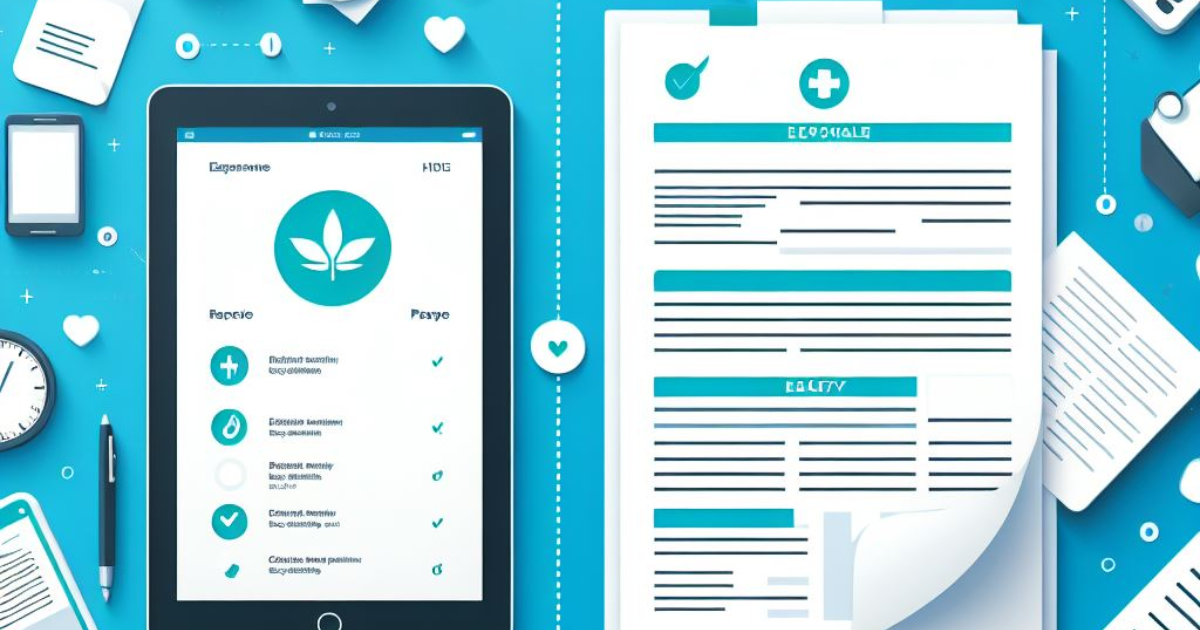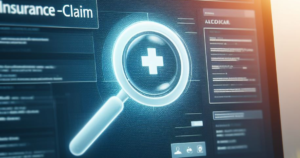Sharing is caring!

In the world of healthcare, the shift from traditional paper records to electronic health records (EHR) has brought about significant changes. Understanding the key differences between EHR and paper records is crucial for healthcare professionals and patients alike. This article aims to unveil these distinctions, shedding light on how EHRs have revolutionized the way medical information is stored, accessed, and shared.
1. Main differences between Electronic Health Records (EHR) and paper records in terms of documentation
Electronic Health Records (EHR) and paper records differ significantly in terms of documentation. While paper records involve physical documents such as charts, forms, and handwritten notes, EHRs are digital systems that store patient information electronically. Paper records require manual entry, storage, and retrieval, making them prone to errors, misplacement, and illegibility. On the other hand, EHRs allow for easy data entry, organization, and quick access to patient information. EHRs also offer features like automatic data backups, data sharing between healthcare providers, and the ability to generate reports and analytics.
2. Electronic charting vs. traditional paper charting in healthcare settings
Electronic charting, facilitated by EHR systems, has revolutionized healthcare settings compared to traditional paper charting. With electronic charting, healthcare providers can input patient data directly into the system, eliminating the need for handwritten notes and physical charts. This digital approach enhances efficiency, accuracy, and legibility of documentation. Electronic charting also enables real-time collaboration among healthcare professionals, as multiple providers can access and update patient records simultaneously. In contrast, traditional paper charting is time-consuming, prone to errors, and can be challenging to share among different healthcare providers.
3. Advantages of using EHR systems compared to paper records
The adoption of EHR systems offers numerous advantages over paper records. EHRs improve patient care by providing a comprehensive and up-to-date view of a patient’s medical history, medications, allergies, and test results. This accessibility to complete and accurate information enables healthcare providers to make informed decisions and provide better quality care. EHRs also enhance communication and collaboration among healthcare professionals, facilitate faster and more efficient documentation, reduce paperwork and storage costs, and improve patient safety by reducing medication errors and adverse events.
4. Accessibility
One significant advantage of EHR systems over paper records is the enhanced accessibility of patient information. EHRs allow healthcare providers to access patient records from any location with an internet connection, enabling timely and informed decision-making. In contrast, paper records are physically limited to the healthcare facility where they are stored, making it difficult to access patient information in emergency situations or when patients seek care from different providers. EHRs also facilitate secure data sharing between healthcare organizations, ensuring seamless continuity of care and reducing the need for redundant tests and procedures.
5. How EHRs improve efficiency and accuracy of patient data management
EHRs significantly improve the efficiency and accuracy of patient data management compared to paper records. EHR systems automate various tasks, such as data entry, result reporting, and prescription ordering, reducing the time and effort required for documentation. This automation minimizes errors associated with manual data entry and improves the legibility of records. EHRs also enable healthcare providers to quickly search and retrieve specific information, eliminating the need to manually review multiple paper documents. Additionally, EHRs can generate reminders and alerts for preventive screenings, medication interactions, and allergy warnings, further enhancing patient safety and care quality.
6. Drawbacks and limitations of paper charting
While paper charting has been the traditional method of documentation in healthcare, it has several drawbacks and limitations. Paper records are prone to human errors, such as illegible handwriting or transcription mistakes, which can lead to miscommunication and compromised patient care. Paper records are also susceptible to physical damage, loss, or theft, putting patient privacy and data security at risk. Retrieving specific information from paper records can be time-consuming, especially when dealing with large volumes of documents. Additionally, paper charting lacks the ability to generate automated reminders, alerts, or analytics, limiting its potential for improving patient care and healthcare outcomes.
7. Enhancing communication and collaboration with EHRs
EHR systems play a crucial role in enhancing communication and collaboration among healthcare professionals. With EHRs, multiple providers involved in a patient’s care can access and update the same electronic record, ensuring that everyone has the most up-to-date information. This real-time collaboration improves care coordination, reduces medical errors, and eliminates the need for redundant tests or procedures. EHRs also enable secure messaging and communication platforms, allowing providers to communicate directly within the system, share important information, and seek consultations easily. This seamless communication and collaboration ultimately lead to improved patient outcomes and satisfaction.
8. Data security and privacy
Data security and privacy are major concerns in healthcare, and EHR systems offer significant advantages over paper records in this regard. EHRs have built-in security measures, such as user authentication, encryption, and audit trails, to protect patient information from unauthorized access or breaches. Paper records, on the other hand, are vulnerable to physical theft, loss, or unauthorized viewing. EHRs also allow for granular access controls, ensuring that only authorized individuals can access specific patient information. Additionally, EHRs provide the ability to track and monitor who accessed or modified patient data, enhancing accountability and reducing the risk of tampering or fraud.
9. Cost implications of transitioning to EHR systems
Transitioning from paper records to EHR systems involves upfront costs, but it can lead to long-term cost savings for healthcare organizations. Initially, there are expenses associated with purchasing and implementing EHR software, training staff, and migrating existing paper records to electronic formats. However, EHRs reduce costs related to paper supplies, storage space, and manual record retrieval. EHRs also streamline billing and coding processes, reducing errors and improving reimbursement rates. Moreover, EHRs enable more efficient workflows, allowing healthcare providers to see more patients and optimize resource utilization. In the long run, these cost-saving benefits outweigh the initial investment.
10. Legal and regulatory differences between EHR and paper records
The use of EHR systems is subject to legal and regulatory requirements that differ from those governing paper records. EHRs must comply with privacy and security regulations, such as the Health Insurance Portability and Accountability Act (HIPAA) in the United States. These regulations mandate the protection of patient information, secure storage, and the ability to track and audit access to electronic records. Paper records, although subject to similar privacy regulations, have different requirements for physical storage, access control, and disposal. Healthcare organizations need to ensure they are compliant with both electronic and paper record regulations to maintain legal and regulatory compliance.
12. Challenges and barriers in transitioning from paper records to EHR systems
Transitioning from paper records to EHR systems can present various challenges and barriers for healthcare organizations. One significant challenge is the initial cost of implementing EHR software, training staff, and migrating existing records. There may also be resistance from healthcare providers who are accustomed to paper-based workflows and may be hesitant to adopt new technologies. Integrating EHR systems with existing healthcare IT infrastructure and ensuring interoperability with other systems can also be complex. Additionally, there may be concerns about data security, privacy breaches, and the potential for system downtime or technical issues. Overcoming these challenges requires careful planning, stakeholder engagement, and effective change management strategies.
14. Impact of EHR adoption on healthcare providers’ workflow and productivity
The adoption of EHR systems has a significant impact on healthcare providers’ workflow and productivity. Initially, there may be a learning curve as providers become familiar with the new system and adjust their workflows accordingly. However, once proficient, EHRs streamline documentation processes, reduce paperwork, and eliminate the need for manual record retrieval. Providers can access and update patient information more efficiently, allowing them to spend more time on direct patient care. EHRs also enable automated alerts and reminders, ensuring that providers stay up-to-date with preventive screenings, vaccinations, and medication management. Overall, EHR adoption leads to improved workflow efficiency, increased productivity, and better utilization of healthcare resources.
In conclusion, the transition from paper records to Electronic Health Records (EHR) brings numerous advantages in terms of efficiency, accuracy, accessibility, and collaboration in healthcare settings. EHR systems offer a comprehensive approach to patient care, enhance data security and privacy, and improve billing and reimbursement processes. While there may be challenges in adopting EHR systems, the long-term benefits outweigh the initial investment. Integrating EHRs with other healthcare technologies further enhances patient care and organizational efficiency. Overall, EHRs revolutionize documentation practices and pave the way for improved healthcare outcomes.




